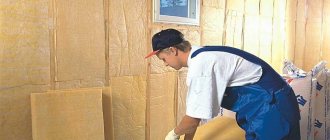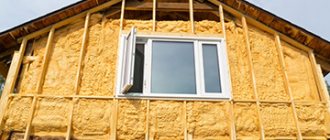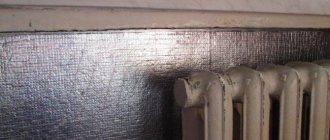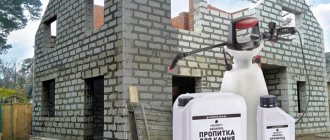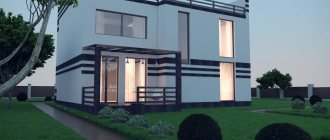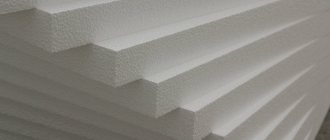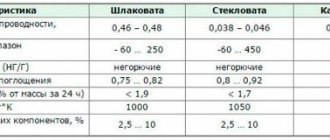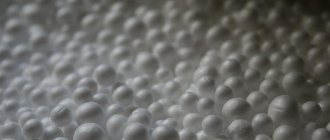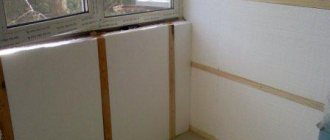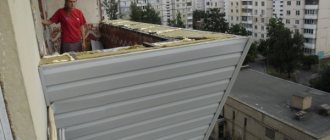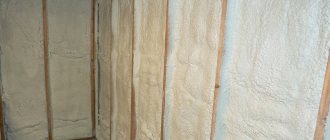From this article you will learn:
- Advantages of external thermal insulation.
- Popular thermal insulation materials.
- Requirements for thermal insulation materials.
- External insulation.
- Advantages of a plaster facade.
- How to properly install insulation on facades.
- Insulation of the house
Proper insulation of a private home not only allows you to save on heating costs, but also extends the life of the building. Improper installation of insulation can lead to moisture, mildew and mold accumulating underneath it. This will accelerate the destruction of the structure. There are a lot of insulation options. In this article we will talk about external insulation, the correct choice of materials, rules for installing insulation, and how to properly insulate a house from the outside with your own hands.
Advantages of external thermal insulation
Insulating the walls from the outside protects them from freezing with the help of internal heat, since the insulation is laid between the walls and the facade cladding. With internal thermal insulation, the walls are constantly exposed to heat and cold, which accelerates their destruction.
There is no condensation on the walls, and if water gets on them, it quickly evaporates.
Living in a house with external insulation is more comfortable and safer for your health. Mold and mildew do not form in such a house, and the rooms retain heat well.
External installation of insulation does not steal the space of the premises, but with internal insulation you will have to sacrifice useful space.
These are the main reasons why a house is insulated from the outside and not from the inside.
| "Wall insulation from the inside" | "Wall insulation from outside" |
|
|
Materials for external wall insulation
The main indicators of insulation are:
- thermal conductivity - the ability of insulation to transfer heat. The lower this indicator, the greater the amount of heat will be saved in the insulated room.
- fire resistance - the ability of insulation to resist the effects of fire. The higher this indicator, the safer the insulated building will be.
- hygroscopicity - the ability of insulation to absorb and accumulate moisture. The lower the value of this indicator, the better. This is explained simply: molecules in a humid environment are located closer to each other than in gas (the air layer in cotton wool). The pressed molecules conduct heat better. An ideal thermal insulation material should have zero hygroscopicity. Because the presence of moisture in it reduces the thermal insulation properties and destroys the material over time. It has been proven that an increase in the humidity of insulation by 1% will lead to a decrease in its thermal insulation properties by 25%. In addition, a building insulated with such insulation will be susceptible to fungi, which will negatively affect the microclimate in the house.
- breathability - the ability of insulation to ensure air movement between the interior and the environment;
- chemical and biological resistance - the ability of insulation to withstand the action of chemicals and living organisms, respectively.
Comparative characteristics of thermal insulation materials in terms of density and minimum permissible layer are given in the table.
Comparative characteristics of thermal insulation materials from the standpoint of thermal conductivity, fire resistance and hygroscopicity.
| Type | Material | Thermal conductivity | Fire resistance | Hygroscopicity |
| Bulk | Slag | ***** | **** | **** |
| Expanded clay | **** | **** | ** | |
| Glasspore | ** | **** | ***** | |
| Perlite, vermiculite | * | **** | ***** | |
| Roll | Basalt fiber | ** | **** | **** |
| Glass wool | ** | ** | **** | |
| Minvata | ** | ** | **** | |
| Stitched mats | ** | ** | **** | |
| Plastiform | ** | *** | * | |
| Izover, URSA | ** | ** | **** | |
| Plate-sheet | Styrofoam | * | * | * |
| Expanded polystyrene | * | * | * | |
| Polyurethane foam | * | * | * | |
| From glass wool and mineral wool | ** | ** | *** | |
| Woody-fibrous | **** | * | ***** | |
| Wall blocks | Expanded clay concrete | ***** | ** | *** |
| Foam concrete | **** | ** | **** | |
| Aerated concrete | **** | ** | **** | |
| Cellular concrete | **** | ** | **** | |
| Gas silicate blocks | **** | ** | **** |
Testing the fire resistance of the most common materials: polystyrene foam, expanded polystyrene and basalt wool, is presented in the video
An ideal thermal insulation material should have these parameters.
| Ideal insulation | Weight | Thickness | Thermal conductivity | Fire resistance | Hygroscopicity |
| min | min | * | ***** | 0 |
Naturally, in practice it is impossible to achieve such indicators. Therefore, most often the materials are combined with each other or with other materials. And the resulting insulation system looks like a multi-layer cake. This scheme allows you to offset the disadvantages of some materials with the advantages of others. The design of a “layered” system requires knowledge and experience from the master.
The table illustrates how thick the insulation must be in order to perform external wall insulation and ensure equal wall insulation.
Comparison table for wall insulation (thickness-efficiency)
At the same time, the installation technology for each of the presented materials is different.
As already mentioned, the insulation of the walls of panel houses from the outside differs from the insulation of the facade of a private house in the increased complexity of the work and a smaller choice of materials. Since in this case only rigid insulation can be used. On the one hand, their price is much lower than all others, on the other, the cost of work is significantly higher.
When designing insulation, you need to take into account the wall material. Sometimes wall material imposes significant restrictions.
For example, the insulation of wooden walls from the outside is carried out only with natural materials such as tow, felt jute or moss. Their use allows you to preserve the natural beauty of natural wood and reduce heat loss through the cracks.
But the insulation of brick walls from the outside can be done with almost any material. It does not impose significant restrictions on the choice of material for insulating gas silicate walls from the outside.
Popular thermal insulation materials
Many materials have been developed for thermal insulation of buildings. The most popular of them:
- Expanded polystyrene;
- Stone wool;
- Extruded polystyrene foam;
Each of these materials has different values of moisture resistance and vapor permeability. These values must be relied upon when choosing insulation. Also of great importance is the climatic zone where the house is located and the method of attaching the insulation, which will protect the premises from high humidity. You also need to take into account the thermal conductivity of the material to calculate the thickness of the insulating layer. This will allow you not to overpay for construction and get the maximum required result for the minimum cost.
Requirements for thermal insulation materials
Before you go shopping for building materials, you need to clarify which material is best suited and whether it meets the necessary requirements.
- Strength. This indicator depends on the density of the insulation:
- If expanded polystyrene is used, then its density is 16-18.5 kg per m3, and the thickness of the blocks is 8-10 cm. The compressive strength with a linear curvature of 10% is at least 100 kPa. Maximum bending strength is 180 kPa. The maximum tensile strength, which is perpendicular to the surface, is 100 kPa.
- If you plan to use stone wool, then you need to use blocks whose density is 45-100 kg per m3, for a wet facade - from 145 to 165 kg per m3.
Installation rules
Before insulating structures using the selected heat insulator, it is necessary to carry out certain preparatory work. They suggest:
- Cleaning the walls of old finishes.
- Removing dust.
- Dismantling of hanging elements and engineering systems.
Next, manipulations are performed to strengthen the wall surface. Here the main work consists of sealing cracks and chips, as well as cleaning crumbling areas, followed by applying a deep penetration primer.
To insulate walls using the “wet” facade method based on materials such as polystyrene foam or mineral wool, the walls must have a flat surface . An adhesive solution is used to smooth out defects. If there is a height difference of up to 5 mm, then it should be applied over the entire area of the insulation. If there are irregularities from 5 to 20 mm, then the composition is laid in the form of cakes on 40% of the area.
When laying the first row of slabs, they are guided by the starting strip, which acts as a horizontal level. The second and all subsequent rows must be placed with a vertical seam shift of 200 mm. In the area of joints, the insulation surfaces must be leveled. In this case, you should ensure that the height difference does not exceed 3 mm.
Before starting treatment with insulation, you should thoroughly clean the walls of debris.
When insulating walls directly near openings, it is necessary to pay attention to ensure that the seams of the slabs do not intersect in the corners. Additionally, it is necessary to strengthen each sheet with umbrella dowels, based on the calculation of 5 pieces per square meter. m. Before applying a layer of plaster to the fixed slabs, they should be reinforced. To do this, a layer of fiberglass is placed on their surface. It is fixed in the middle with an adhesive solution with a layer of 5-6 mm.
External wall insulation is the most effective way to reduce heat loss in the rooms of the house. Even if the home is heated by medium-power appliances, even in this case, with the help of a properly carried out procedure, it is possible to create a warm microclimate in a private home. Then cold air will no longer flow into the rooms from the street. All that is required is the use of suitable material and the performance of all work in accordance with the rules of existing technology. This will have a positive effect on the quality of the insulation design and will provide an optimal heat saving effect.
Advantages of a plaster facade
- Plaster thermal insulation is one of the most inexpensive insulation options.
- A wet façade protects walls from internal dew formation, which can quickly cause them to rot or freeze.
- Due to the fact that the wet facade weighs little, there is no need to strengthen or change the foundation before installing it.
- The final finish of a wet facade can be almost anything. It can be periodically updated so that the house always looks like new.
- The service life of a plaster facade is 25-30 years.
- Walls with wet insulation breathe, and a favorable microclimate is naturally maintained in the rooms throughout the year.
- Plaster insulation extends the service life of walls and reduces heat loss.
- This façade has excellent sound insulation.
- Installation of a wet facade can be carried out at any height, regardless of what the house is built of.
A ventilated façade is similar to a well façade, but here the external layer is cladding – siding, imitation timber, etc.
Which material to choose
To insulate houses, it is recommended to use environmentally friendly materials that allow the walls to “breathe”: mineral wool, foam glass, stone or ecowool.
But, along with excellent heat-saving properties, insulation materials of natural origin have increased hygroscopicity - they quickly absorb moisture, retain it in their thickness, and when frost sets in, they freeze and lose their ability to shield the cold.
In order to protect the insulating layer made of natural materials, it is recommended to use vapor barrier and waterproofing membranes, which screen out moisture and do not interfere with the ventilation of the walls.
Unlike mineral wool and other types of insulation made from natural raw materials, thermal insulation made from foamed polymers practically does not absorb moisture and lasts quite a long time. If the installation of stone or glass wool involves certain difficulties and requires compliance with safety standards, then the installation of polystyrene foam, polyurethane foam or polystyrene foam can be quickly and easily done independently. At the same time, the thermal insulation properties of these materials are slightly worse than mineral wool.
Insulation of the house (Is it worth it to insulate the house, what will we get at the output)
It's definitely worth insulating your house. At a minimum, the result will be savings on heating, since the house now retains heat better, and has a pleasant appearance. Also, external insulation will extend the life of the building, due to the fact that the walls will not freeze and fungus and mold will not form on them.
If you decide to work on your own, then a suspended facade is best suited, the insulation of which must be selected individually for each house. But it is best to take care of insulation at the design stage of the building.
Insulation of the house must be carried out at least a year after completion of construction to allow the building to settle. Otherwise, the facade will crack, the structure will become deformed, and areas with an increased risk of excess moisture and mold will appear.
Methods of external thermal insulation
Conventionally, methods of external thermal insulation can be divided into wet and dry. Each of them does an excellent job of preserving heat, but the technology for performing the work and the materials used will differ.
Wet facade
This method is most popular, because the materials used are environmentally friendly, the work performed is relatively simple, and the financial costs are low.
Thermal insulation using the wet method involves covering the walls of the house with plaster, the layer of which is about 40 mm.
With the wet method, work is carried out in the following order:
- The wall is thoroughly cleaned of dirt and defects are eliminated.
- The surface is coated with a primer.
- Vapor barrier material is fixed if available.
- The insulation boards are fixed with an adhesive composition.
- Additional fastening is done with dowels.
- The adhesive composition is applied to the surface of the insulation.
- Mesh reinforcement is performed.
- After the glue has completely dried, an adhesive primer is applied.
- The surface is plastered.
It is important to understand that external insulation of building facades using this method is not recommended at high humidity and if the temperature is below -5C. The homeowner should also take a responsible approach to finding workers for plastering.
The wet method has many advantages, but like all technologies it also has its disadvantages. It is susceptible to mechanical damage and deteriorates its thermal insulation characteristics over time. If low-quality materials were used during the work, then over time the plaster may fall off,
Wet façade design diagram
Dry method
Insulation of building facades using the dry method is carried out using a facing material that is attached to the frame.
The algorithm for performing thermal insulation work using the dry method is as follows:
- The surface is cleaned and serious defects are eliminated.
- If there is a vapor barrier material, it is secured.
- The frame is installed for insulation. It can be made from bars and boards or from a metal profile. Metal profile racks are installed after fixing the insulation.
- A starting profile is installed to fix the first row of heat insulation.
- Thermal insulation is attached with glue, and after drying it is fixed with dowels.
- Using a construction stapler, waterproofing and wind protection are secured.
- The cladding is installed according to the manufacturer's instructions.
There are no requirements for weather conditions when carrying out dry insulation work.
Dry thermal insulation includes:
- Insulation using heavy plaster systems;
- Ventilated curtain façade;
- Insulation using siding panels.
Dry and wet methods of façade insulation
